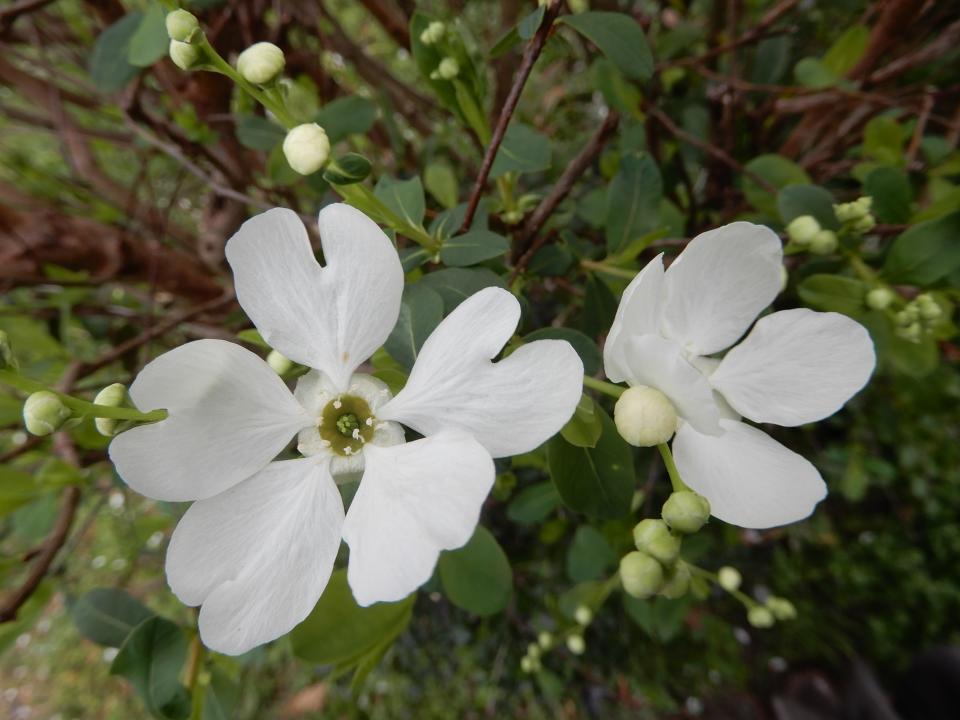This spring blooming shrub is a real gem | Mystery Plant
Some of you, such as myself, really like to see the end of winter roll around each year. As with all the other seasons, this process is rather gradual, and, there are many signs of spring’s coming, sometimes these working as “teases”: maple and elm trees budding, robins and cedar wax-wings all over the place, daffodils, crocus, and little weeds blooming in the lawn.
Since my birthday seems always to be on Valentine’s Day, I have figured out that that means 6 more weeks of “winter,” at least in my neighborhood. All things considered, I think that it’s better that the coming of spring is indeed a gradual, weeks-long process, rather than like the sudden opening of a door.

I hope that you are starting to see some signs of spring wherever you are, and that your spring will be wonderful. Here’s another one of spring’s signs, one in my backyard.
We “inherited” this shrub when we moved into the house, just short of 40 years ago. It has bloomed every single spring, right on cue, and it doesn’t matter what the previous weather has been, or how many time it’s been whacked by the weed-eater.
It's tough and it's beautiful. Our shrub, pearl-bush, Exochorda racemoca, has been pruned lots of times over the years, and it likes to send up straight, wand-like branches, covered with flowers. Perhaps the most striking thing about it is that at the onset of blooming, there will be hundreds of bright white buds, and I mean BRIGHT, especially with the drab, late winter background.
The swelling buds end up as spherical as kid’s marbles (Oh wait: do kids still play with marbles?) and since they are white, they look just like big pearls scattered along the stems. A wonderful effect! Of course, the buds open, with five pure white petals and a ring of 10 stamens down at their base.
Farther below the “cup” formed by the sepals, stamens and petals, will be 5 green pistils. The flowers have the slightest understated sweet fragrance, but the real glory is the spectacle from the buds and open blossoms. After blooming is finished, the ovary of each flower will produce a brown, dry capsule, which is 5-angled.
This floral cup mentioned above is what we call a “hypanthium,” and this is characteristic of just about any plant you can think of that belongs to the rose family (that is, “Rosaceae”). The flowers of apple, pear, blackberry, spiraea, plum, cherry, peach, quince, hawthorn, and loquat (among others), all of which are considered members of the Rosaceae, share a hypanthium.
In this family, it’s easier to separate members into groups based upon the way their fruits are characterized, not by their flowers.
This mysterious shrub is not native, but originates in eastern Asia. Fortunately, it seems not to be invasive. It’s an old-timey shrub, I think, perhaps more commonly seen in gardens of yesteryear, but it’s available now from nurseries. And when you see it blooming, get ready for spring.
John Nelson is the retired curator of the Herbarium at the University of South Carolina, in the Department of Biological Sciences. As a public service, the Herbarium offers free plant identifications. For more information, visit www.herbarium.org or email johnbnelson@sc.rr.com.
This article originally appeared on Tallahassee Democrat: Beautiful spring blooming shrub is a real gem | Mystery Plant

